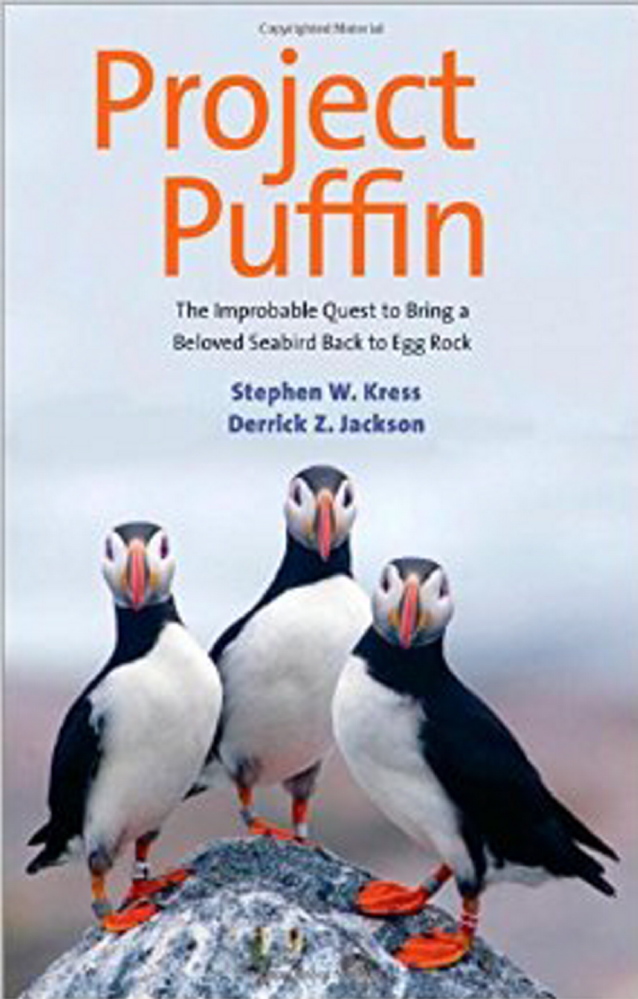Where would Maine be without moose, loons or puffins? Icons of our wild woods, lakes and ocean, they support a massive industry of kitsch, like the chocolate moose, the Welcome to the Looney Bin “collectibles,” and the ubiquitous “No Puffin” sign. All three creatures have had to be rescued from past human assaults in Maine, but only puffins were extirpated, mostly as by-catch from the 19th century plumage trade (plumage hunters found them an easy source of food, as did fishermen.)
When I was a teenage birdwatcher, puffins were high on my “most wanted” list. A sailor friend from Bar Harbor was always promising to take me out to Machias Seal Island where puffins still bred, but it proved too far away from my English school. In 1980, when I was working for Massachusetts Audubon Society, a New York Times article caused great excitement: Celanese Corporation was funding a young scientist named Steve Kress to jump-start a puffin colony in the Gulf of Maine. Eight years later, upon arriving at Maine Audubon, I visited the puffin project’s headquarters at Hog Island. Wearing his trademark woolen tam o’shanter, Steve gave me the royal tour. By that time, there were 16 pairs of puffins nesting on Eastern Egg Rock. Today there are well over 100.
“Project Puffin” tells the story of their recovery, from Kress’s first sight of puffins on Machias Seal Island and his discovery in old records that they had once thrived as close to Hog Island (where he was a camp instructor) as Eastern Egg Rock. Since this is also a memoir, told in partnership with Boston Globe columnist Derrick Z. Jackson, the book goes back even further. A delightful chapter relates Kress’s boyhood in land-locked Columbus, Ohio, where he filled his parents’ house with wildlife; although she feigned horror, his mother considered it all “jolly material at her next canasta game.”
Kress’s achievement in returning puffins to Maine is impressive both as a conservation victory and as an example of personal devotion and patience. In order to fledge a cohort of birds that would regard Egg Rock as their home, he had first to transplant (from a healthy Canadian colony) chicks that had yet to leave the burrows in which they were born. Once successfully installed in, then fledged from, their new Maine home, he could only wait. Puffins spend their first years – no one then knew how many – at sea. It took four before one returned, and eight years for the first chick to hatch on Egg Rock since the 1800s.
As an author, Kress’s charm and wit bring the project to life through myriad details following its joys and woes. Beyond a broad grounding in ecological principles, he and his team had to make up what they were doing as they went along. One of their signature successes was the design of “puffin condos” in which they installed the chicks, each one with a “brightly painted yellow placard with… a street address.”
Less successful was the Robo Ranger, a robot designed to scare away gulls but whose intricate wiring could not stand up to the damp, salty conditions prevailing on Egg Rock. Worries ranged from high tides that might flood their artificial homes to the possibility that “chicks might stub their toes” going to and fro.
One benefit of the “waiting years” was the time it allowed for investigating other conservation possibilities on seabird islands. Just the removal of predatory black-backed and herring gulls quickly yielded ecological changes, not only in the birds but in the flora. Techniques pioneered by the project were soon being used beyond the Gulf of Maine as well. Decoys and recorded vocalizations are now standard tools for restoring colonial avifauna worldwide. Kress describes some of those that he has been involved with, ranging from murres on the West Coast to petrels in the Galapagos.
While essential to success, singleness of purpose – perfectly symbolized by hours of staring into the fog with a spotting scope – can invite tunnel vision. I would have liked to know more about some asides in “Project Puffin,” such as the absence of “human-wary” cormorants or, on the Galapagos, the implications of catching more short-eared owls than petrels, not to mention a couple of intersecting research projects that get short shrift.
Project Puffin makes a strong case for going beyond laissez-fair conservation that leaves recovery to nature. But “playing God” inevitably leads to increasingly tricky questions. Eliminate black-backed and herring gulls to gain a puffin colony? No problem. But then laughing gulls (a species of special concern in Maine) return with the puffins and need to be controlled. Increased numbers of bald eagles and peregrine falcons also pose threats. Kress doesn’t suggest culling them, but one wonders where and how the line is drawn. “Project Puffin” is a serious book that raises immensely important questions.
Thomas Urquhart is a former director of Maine Audubon and the author of “For the Beauty of the Earth.”
Copy the Story LinkSend questions/comments to the editors.



Success. Please wait for the page to reload. If the page does not reload within 5 seconds, please refresh the page.
Enter your email and password to access comments.
Hi, to comment on stories you must . This profile is in addition to your subscription and website login.
Already have a commenting profile? .
Invalid username/password.
Please check your email to confirm and complete your registration.
Only subscribers are eligible to post comments. Please subscribe or login first for digital access. Here’s why.
Use the form below to reset your password. When you've submitted your account email, we will send an email with a reset code.